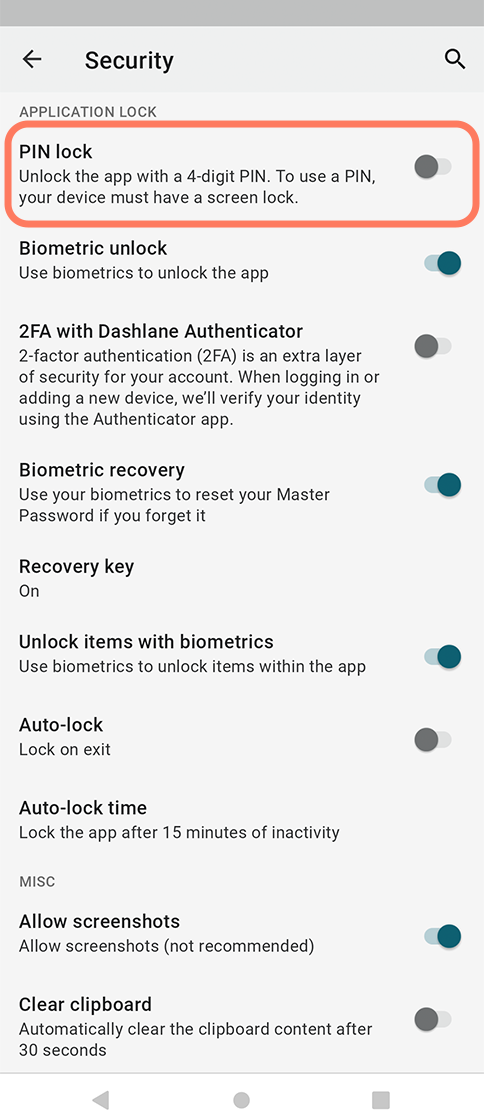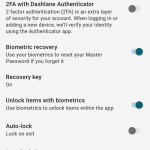To turn off auto-lock on Android, go to Settings, tap Security or Lock screen, then choose None or a longer time interval. Are you tired of your Android device constantly auto-locking on you?
It’s frustrating to repeatedly unlock it every time. We’ll guide you through the simple steps to disable auto-lock on your Android device. By following these easy instructions, you can customize your device settings to prevent it from automatically locking, giving you more control and convenience in using your smartphone or tablet.
Let’s dive in and learn how to keep your Android screen from locking on its own.
Why Auto Lock Is Important
Auto lock helps protect your Android device from unauthorized access.
Ensures that data remains safe in case of loss or theft.
Contributes to enhanced battery life by conserving power.
However, it can be annoying to enter passwords frequently.
Turning off auto lock balances security with convenience.
Credit: support.nordpass.com
Understanding Auto Lock On Android
Learn how to disable auto lock on your Android device to prevent it from locking automatically. Easily customize your settings to keep your screen unlocked for longer periods. Turn off auto lock and enjoy uninterrupted usage of your Android phone.
| What is Auto Lock? | How Auto Lock Works |
| Auto Lock is a feature on Android | It locks your device after a period |
| of inactivity to secure your data. | It prevents unauthorized access to your device. |
| You can adjust the Auto Lock settings | to your preference in the device settings. |
| Understanding Auto Lock helps | you customize it for your convenience. |
Pros And Cons Of Auto Lock
Auto Lock on Android devices can be a useful security feature, but it also comes with its share of pros and cons. Let’s take a look at the benefits and drawbacks of this feature.
Security Benefits:
- Prevents unauthorized access: Auto Lock ensures that your device is automatically locked after a period of inactivity, preventing unauthorized access to your personal data.
- Protects sensitive information: If your device gets lost or stolen, Auto Lock adds an extra layer of protection by requiring a passcode or biometric authentication to unlock it.
- Peace of mind: With Auto Lock enabled, you can feel more secure knowing that your device is safeguarded against potential breaches.
Potential Drawbacks:
- Inconvenience: Auto Lock can be inconvenient if you frequently use your device and have to repeatedly unlock it.
- Quick access limitations: With Auto Lock enabled, you might miss out on quickly checking notifications or accessing certain features without having to unlock your device.
- Battery drain: Auto Lock can contribute to battery drain, as it requires the device to constantly monitor activity and lock itself accordingly.
Ultimately, the decision to turn off or keep Auto Lock enabled on your Android device depends on your individual needs and preferences. Assess the security benefits against the potential drawbacks to make an informed choice.
How To Change Auto Lock Settings On Android
To change the auto lock settings on your Android device, you can access the settings menu by tapping on the ‘Settings’ app icon. Once in the settings menu, locate the ‘Security’ or ‘Lock Screen’ option. Under the security or lock screen settings, you will find the auto lock option. You can then adjust the auto lock settings to your desired time frame or turn it off completely based on your preference.
Adjusting Auto Lock Time
Sure, I can help with that. Here is a short paragraph in HTML format: “`htmlWhen you want to shorten the auto lock time on your Android device, go to the Settings app, then select Security and Location. Tap Screen Lock, then enter your PIN, password, or pattern. Choose a shorter auto lock time, such as 15 seconds, from the options provided. To extend the auto lock time, follow the same steps, but choose a longer time interval that suits your preferences. You can easily customize the auto lock time on your Android device to better suit your needs.
“` I hope this helps! Let me know if you need anything else.Disabling Auto Lock On Android
Turning off auto lock on your Android device can be quite convenient, especially when you want to use your device without interruptions. Android offers two options to disable auto lock: temporarily and permanently.
To temporarily disable auto lock on your Android, you can follow these simple steps:
- Go to the “Settings” app on your device
- Scroll down and tap on “Display”
- Select “Screen timeout” or “Sleep” option
- Choose “Never” or the desired time interval
To permanently disable auto lock on your Android, you can use a third-party app or follow the steps below:
| Method | Procedure |
|---|---|
| Method 1 | Navigate to “Settings” > “Security” > “Screen lock” > Select “None” |
| Method 2 | Download a third-party lock screen app and set it to “None” |
By following these instructions, you can easily turn off auto lock on your Android device, either temporarily or permanently, based on your preference and needs.
Best Practices For Managing Auto Lock
To turn off auto lock on Android, navigate to Settings > Security > Screen Lock. Choose “None” to disable auto lock. Customize Auto Lock settings in “Display” settings for your preferred duration. Remember to balance security with convenience.
Credit: help.roboform.com
Credit: support.dashlane.com
Frequently Asked Questions Of How Do I Turn Off Auto Lock On Android
How Can I Disable Auto Lock On My Android Device?
To turn off auto lock on your Android, go to Settings > Security > Screen lock, enter your PIN, password, or pattern, and select “None” or “Swipe” as the screen lock type.
Where Can I Find The Auto Lock Settings On My Android Phone?
You can find the auto lock settings in the Security section of your Android phone’s Settings menu. Look for the “Screen lock” or “Lock screen” option, where you can configure your device’s auto lock settings.
Are There Any Potential Risks Associated With Turning Off Auto Lock On Android?
Disabling auto lock on your Android device may compromise its security, especially if it’s lost or stolen. Without auto lock, unauthorized users can access your personal data. Use caution and consider alternative security measures before disabling auto lock.
Conclusion
To sum up, disabling the auto lock feature on your Android device is a simple yet effective way to enhance your user experience. By following the steps outlined in this blog post, you can take control of your device’s screen lock settings and customize them according to your preferences.
Whether you want to avoid the inconvenience of repeatedly unlocking your device or simply want to enjoy uninterrupted usage, turning off auto lock can be a game-changer. So, go ahead and give it a try – you won’t be disappointed!









